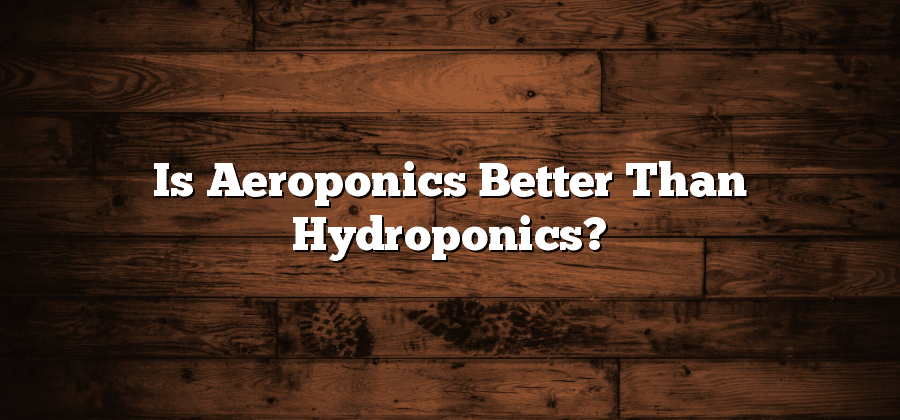Advantages of Aeroponics over Hydroponics
Aeroponics, an innovative form of soilless cultivation, offers several advantages over its counterpart, hydroponics. Firstly, aeroponics allows for superior oxygenation of the plant’s root system. With the roots suspended in a nutrient-rich mist, they receive a continuous supply of oxygen, promoting faster and healthier growth. Unlike hydroponics, which uses water as a growing medium, aeroponics eliminates the risk of root suffocation and rot, leading to stronger, more resilient plants.
Secondly, aeroponics offers enhanced water and nutrient efficiency. In hydroponics, plants are submerged in water, which can lead to the overconsumption of both water and nutrients. Conversely, aeroponic systems use minimal amounts of water, as the mist is recycled and reused efficiently. This not only conserves water resources but also reduces the cost and environmental impact associated with nutrient replenishment. Additionally, the precise control over nutrient delivery in aeroponics ensures that plants receive the exact nutrients they need, resulting in optimal growth and minimized waste.
Disadvantages of Aeroponics compared to Hydroponics
One drawback of aeroponics compared to hydroponics is the higher initial setup cost. Aeroponic systems require specialized equipment such as misting nozzles, pumps, and timers, which can be expensive to purchase and install. In contrast, hydroponic systems can be set up using more basic components, making them a more cost-effective option for growers with limited budgets.
Another disadvantage of aeroponics is the increased risk of system failure. Since aeroponic systems rely heavily on precise misting and nutrient delivery, any malfunction or interruption in these processes can have a significant impact on plant health. For example, if the misting nozzles become clogged or the pump stops functioning, the plants may not receive adequate moisture and nutrients, leading to stunted growth or even death. In hydroponics, the risk of system failure is generally lower since the nutrient solution is continuously circulating, reducing the likelihood of critical interruptions.
Water and Nutrient Efficiency in Aeroponics
Aeroponics, a soilless cultivation method, offers significant advantages in terms of water and nutrient efficiency. By misting nutrient-rich water directly onto plant roots suspended in air, aeroponics ensures that every droplet is maximally utilized. Traditional hydroponics systems, on the other hand, rely on a continuous flow of nutrient solution, potentially leading to wastage and runoff.
In aeroponics, the fine misting system not only delivers water and nutrients efficiently, but also promotes oxygenation of the root zone. This, in turn, enhances nutrient uptake and overall plant growth. With precise control over the amount and timing of nutrient delivery, aeroponics allows for precise optimization of water and nutrient usage, resulting in reduced consumption compared to traditional hydroponics. By minimizing water and nutrient waste, aeroponic systems not only offer environmental benefits but also contribute to cost savings, making them an attractive choice for growers seeking efficiency and sustainability.
Plant Growth and Productivity in Aeroponics Systems
Plant growth and productivity in aeroponics systems is a topic of great interest among researchers and horticulturists. Aeroponics, a method of growing plants in a mist environment without the use of soil or a solid medium, has shown promising results in enhancing plant growth and overall productivity.
One key advantage of aeroponics is that it provides plants with a highly oxygenated environment. This promotes faster root growth and nutrient uptake, leading to accelerated plant development and increased yield. The misting system used in aeroponics ensures that the roots receive an optimal amount of water and nutrients, allowing the plants to absorb them effectively. Additionally, the absence of soil in aeroponics eliminates the risk of soil-borne diseases, providing plants with a healthier growing environment. This contributes to improved plant health, root structure, and overall productivity.
Another aspect that contributes to the superior growth and productivity in aeroponics systems is the precise control over nutrient delivery. Nutrients are delivered in a fine mist directly to the roots, ensuring that plants receive the optimal balance of nutrients they need to thrive. This reduces wastage and allows plants to efficiently absorb the necessary elements for growth. Furthermore, the ability to tailor the nutrient solution precisely to the plant’s requirements ensures that plants receive the perfect blend of macronutrients, micronutrients, and trace elements, further enhancing their growth and productivity.
In conclusion, aeroponics systems offer numerous advantages for plant growth and productivity. With the provision of an oxygen-rich environment and precise control over nutrient delivery, plants in aeroponics systems experience accelerated growth, healthier root systems, and improved overall productivity. The advancements in this field continue to prove the potential of aeroponics as a highly efficient and sustainable method of cultivating crops.
Root Health and Disease Prevention in Aeroponics
Root Health and Disease Prevention in Aeroponics
In the world of agriculture, maintaining root health is vital for the overall success of plant growth. When it comes to aeroponics systems, this method offers several advantages for root health and disease prevention. One of the key benefits is the elimination of soil-borne pathogens, as aeroponics does not use any soil medium. This minimizes the risk of root diseases caused by fungi, bacteria, or viruses that thrive in traditional soil-based systems.
Furthermore, the unique design of aeroponics systems promotes optimal oxygenation for the roots. By suspending the plants in the air and misting nutrient-rich water directly onto the roots, the plants receive an ample supply of oxygen while benefiting from efficient nutrient absorption. This oxygenation process not only enhances root health but also strengthens the plants’ overall immune system, making them more resistant to root diseases. Additionally, the constant exposure to oxygen prevents roots from becoming waterlogged, reducing the risk of root rot and promoting robust growth.






